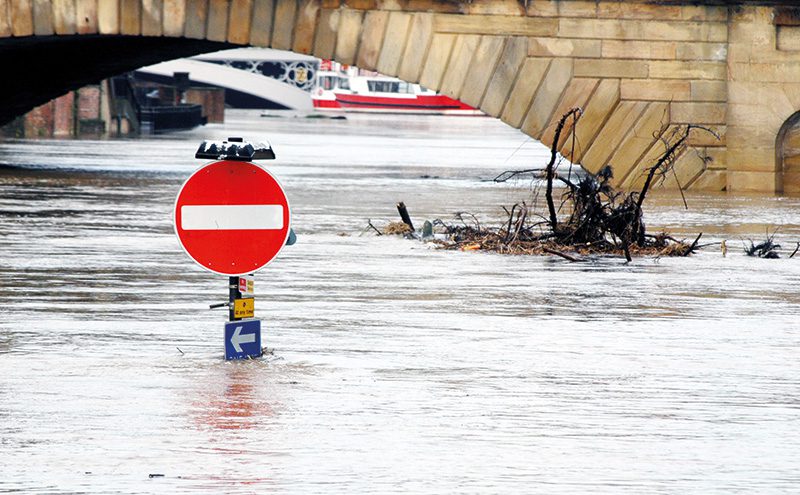Simon Crowther of Flood Protection Solutions reflects on the recent spate of business closures in his sector, what it means for UK flood resilience, and what might be done

Flooding is the biggest threat to the UK as a result of climate change (Jowit, 2018[1]), and yet this year, we have already seen four businesses in the flood protection sector going out of business. It is vital that we have companies in the private sector who can provide flood protection measures, as the damage and distress that flooding causes is huge.
One of the companies which went into administration came as a shock to the industry. UK Flood Barriers staff were informed on 26 March 2018 that the company was in administration and they were being made redundant. The firm was a major player in the sector, having completed schemes for the Environment Agency and having installed a self-activating flood barrier to protect a new science block at New York University from the Hudson River.
The closure resulted in the loss of 34 jobs; these individuals are likely to have very desirable skills to the flood defence sector, but as the sector is so niche, they may end up in employment outside of it, and their skills will be lost.
Whilst I cannot comment on the individual cases of companies that have been unable to continue operating, it appears there must be some external factors affecting the industry as a whole – since so many businesses have been affected.

Race to the bottom?
One issue that seems to plague the sector is a common problem with all public sector contracts. John Alexander from Aquobex raised the issue on Twitter that many contracts are focused on price and not quality. This leads to a ‘race to the bottom’ driving down standards in the sector. Unless businesses are able to make a profit, they cannot reinvest in staff training, research & development, or new equipment.
Another issued is ‘feast and famine’ funding. I have raised this issue regularly before. The private sector is expected to respond rapidly to a knee-jerk investment in the sector, rather than a planned long term approach to allow growth, training and innovation.
After the 2013/14 floods there was a ‘Repair & Renew’ grant available to homes and businesses to establish flood resistance and/or resilience measures to reduce the risk of future flooding or minimise its impact. The Government expected the flood defence sector to suddenly be able to accommodate this increase in work. Subsequently the funding has all dried up, and left a drought of work in the flood protection sector. The next time there is funding available, the Government will expect the private sector companies once again to cope with the demand, yet the skilled workers will have left the sector and will be be working elsewhere.
Voices no longer in the trenches
One such former flood worker is Fiodar Sazanavets, now a senior software developer at Blackbox. He summarised the background to his carreer move on LinkedIn: “I worked in analysis in the flood risk industry at the beginning of my graduate career. The job explicitly required a Masters degree. I had to leave it and become a full-time software developer, because, for all of my effort, I was paid less than a warehouse operator was at Tesco. It was a fulfilling job, and I sometimes miss it. But working in the industry meant I had to sacrifice pretty much all other aspects of my life, so there is no way back for me.”
This is unfortunately a prime example of the sector being underfunded, and skills subsequently being lost from it.
We understand DEFRA’s policy goals are that flood resilience and protection becomes a normal business not reliant on government grants for its survival, and that this is what the Property Flood Resilience Action plan and ongoing work by the Roundtable are designed to drive.
Whilst in principle this makes sense, there is simply not enough education or awareness with flood protection for this to be the case yet. To quote Harries’ submission to a 2008 flood repair sector workshop [2]: “Following a single flood, or [instance where someone acquired] knowledge of flood risk, only 6% of people adapt their property to become flood resilient.”
I believe there are numerous reasons for the low uptake in flood resilience including:
• There is a misconception or belief that the flooding will never happen again and was a ‘one – off’.
• People do not accept that they are at risk of flooding as they haven’t experienced it.
• Property owners may not know they are at risk of flooding
• They take the view that only the authorities can manage flood risk and there is nothing they can do, or should do.
• They bury their head in the sand as the flood risk is too painful to think about.
• People do not want to highlight that their house is at risk of flooding by installing property level resilience.
The last point makes it incredibly tricky to undertake marketing ones’ services in the flood defence sector. Even successful flood defences go unreported as case studies, as homeowners do not want to highlight that their house is at risk of flooding.
What needs to be done?
If DEFRA truly want flood protection to become a normal business, I believe there is an incredible amount of work that needs to be done to educate, raise awareness and drive a change in behaviours. At present there is too much focus on the Return on Investment of flood defences, and not on the emotive aspects. If we want to capture the public’s attention, we need to emotively engage them about the upheaval, expense and stress that flooding causes. A great example of this was Blue Planet 2. Councils have been encouraging recycling of plastics for years, yet the public became engaged when they saw a female pilot whale and her baby, which sadly died due to man-made plastics and contamination. In the weeks following, plastic recycling rocketed.
To drive this, I believe there needs to be a large PR campaign with emotive videos or public information films around just how traumatic flooding is. I have raised this regularly, but have never been consulted with or had the issue discussed. Flooding is after all the biggest threat to the UK as a result of climate change, and it poses a real threat to life and property: 40% of businesses close following an incidence of flooding.
Driving a change in behaviours around investing in flood protection is now going to be incredibly difficult as the Government is having to backtrack. The next homes that flood will surely question why they aren’t eligible for the £5000 grant and why they have to fund flood defences themselves. This point is illustrated by the town of Southwell, Nottinghamshire, which flooded in the summer of 2013. Grant funding was not available then, yet the following year when it was awarded to other areas, they lobbied and campaigned and were retrospectively awarded the grant. After all the grants issued, it is going to be incredibly hard to justify to the next flood victims that they must protect themselves.

If we can reduce flood risk, we help reduce the social, environmental and economic impacts.
Going forwards, I believe we need to see more collaboration between the public and private sectors. We need an awareness campaign or public information films to raise awareness and education about flooding, along with what can be done to prevent it. I’m concerned that existing Government frameworks may lock-in the same products and fail to drive innovation in the sector. We also need to see more collaboration between existing businesses so that the best solutions can be offered to customers.
It is a real concern that more flood defence companies will close and we’ll be left without anywhere to turn the next time there is a flood, or that if funding becomes available again in a ‘knee-jerk’ reaction, that unskilled people will found companies to capitalise on this, with the result being a quality and expertise slump in the sector.
Having been a 2007 flood victim, and experienced the upheaval, expense and stress that flooding causes, I’m on a mission to reduce flood risk across the UK, and always happy to help where I can.
References
[1] Jowit, J. (2018). Flooding rated as worst climate change threat facing UK. [online] The Guardian. Available at: https://www.theguardian.com/environment/2012/jan/26/floods-worst-climate-change-uk [Accessed 17 Apr. 2018].
[2] Harries, T. (2008). Public perceptions and adaptations to flood risk. In Flood Repair Network Workshop no 4, 08/05/08, ed. D.G. Proverbs, Embassy House: Birmingham UK, 2008.
[3] Environment Agency (2009). Flooding in England: A National Assessment of Flood Risk. Bristol: Environment Agency.






